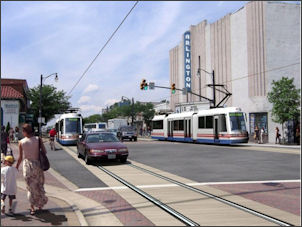by James A. Bacon
Arlington County’s surprise decision yesterday to cancel proposed streetcar projects for Columbia Pike and Crystal City should not be seen as a rejection of the concept of streetcars but a rejection of the funding mechanism chosen by the board that asked taxpayers to bear the fiscal risks while property owners enjoyed the benefits.
Arlingtonians, who voted John Vihstadt to the County Board earlier this month in an election that had become a referendum on the streetcar projects, questioned whether the $550 million price tag justified the purported economic development benefits. Board Chair Jay Fisette cited the decisive election results in canceling the project for which he and other board members had spent 15 years shepherding through the planning and fund-raising process.
One big problem for streetcar backers was defending the Columbia Pike project in the face of escalating cost estimates. The $358 million price tag was up $48 million from a federal cost estimate last year and up $100 million from a previous county estimate. County officials, with years of planning invested in the project, maintained that the benefits still outweighed the costs. A substantial majority of citizens were skeptical, and they said the county’s transportation needs could be met more cost-effectively with improved bus service.
Streetcar advocates said that the investment in fixed streetcar assets would encourage property owners along Columbia Pike to invest in upgrades and infill along the route. In theory, rising property tax revenues would more than offset the county’s $170 million share of the capital costs as well as ongoing operating costs. Moreover, the county’s share of the funds would come from a special commercial real estate tax dedicated to transportation projects.
That is not an unreasonable argument to make, although the forecast of rising property values does require a leap of faith. In effect, county officials were willing to to invest local funds for both streetcar lines in the belief that the revenue from increased property values ultimately would exceed the costs. In effect, they were saying, “Trust us. Build it and the development will come.” It became harder to maintain that the project would be a net fiscal benefit when the estimated cost jumped $100 million.
County officials could have changed the political dynamic if they’d embraced the logic espoused here on Bacon’s Rebellion — moving to a system in which users and beneficiaries pay for the project. In previous columns, I advocated funding the project through a special tax district on property owners along Columbia and a separate district in Crystal City.
If the Columbia Pike streetcar will do as much to stimulate increased property values as claimed, the property owners along the route will be the main beneficiaries. Why should property owners enjoy a massive windfall without contributing anything directly toward the project? (The special commercial tax that would pay for the project comes from all over Arlington, not just the area affected.) If property owners believe that the value created would exceed the projected cost, they should be willing to bear that cost themselves. The county could add sweeteners in the form of increased density allowances, as needed. Using special tax districts to finance the streetcar projects would place the burden and the risk where it belongs: on the property owners who collectively stand to gain hundreds of millions, if not billions, of dollars in economic value, not the general taxpayers.
If the County Board had structured the deal this way, taxpayers would have had no cause to bellyache. The projects never would have been politicized in the way they were.
Of course, structuring the projects around special tax districts would create a political risk that property owners would not support them. But if the chief beneficiaries refused to support the project, what signal would that send? It would send the signal that the projects won’t have the wealth-creating effects claimed for it, that the projects cannot be economically justified, and that the projects shouldn’t be built.
Instead of giving up, the Arlington Board should restructure the deal as a special tax district in which the local funding share is paid for by property owners affected by the project (rather than commercial property owners throughout the county). If the property owners bite, they’ll have a project. If the property owners balk, then it’s time to acknowledge that the putative benefits aren’t there.



